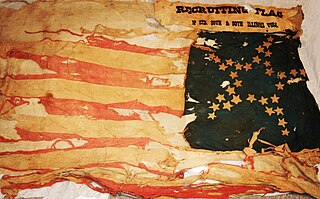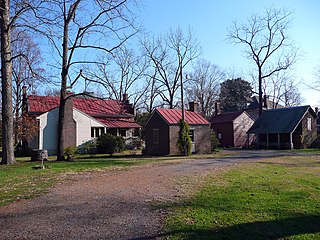
The Army of the Tennessee was a Union army in the Western Theater of the American Civil War, named for the Tennessee River.

The Battle of Kennesaw Mountain was fought on June 27, 1864, during the Atlanta Campaign of the American Civil War. It was the most significant frontal assault launched by Union Maj. Gen. William T. Sherman against the Confederate Army of Tennessee under Gen. Joseph E. Johnston, ending in a tactical defeat for the Union forces. Strategically, however, the battle failed to deliver the result that the Confederacy desperately needed—namely a halt to Sherman's advance on Atlanta.

The 41st Ohio Infantry Regiment was an infantry regiment in the Union Army during the American Civil War.
The 17th Wisconsin Infantry Regiment was an infantry regiment that served in the Union Army during the American Civil War. It was popularly known as the Irish Brigade, due to its composition of mostly Irish American immigrants.
The 95th Regiment Illinois Volunteer Infantry was an infantry regiment that served in the Union Army during the American Civil War.

The 80th Illinois Volunteer Infantry Regiment was an infantry regiment that served in the Union Army during the American Civil War. The regiment was composed of ten companies that drew primarily from eight southern Illinois counties. Over the course of the war the regiment traveled approximately 6,000 miles, and was in over 20 battles.

The 88th Illinois Infantry Regiment was an infantry regiment from Illinois that served in the Union Army during the American Civil War. The regiment mustered into service in September 1862 and was engaged at Perryville a month later. The unit subsequently fought at Stones River, in the Tullahoma campaign, at Chickamauga, at Missionary Ridge, in the Atlanta campaign, at Franklin, and at Nashville. The 88th Illinois especially distinguished itself at Stones River, Missionary Ridge, and Franklin. The regiment mustered out of service in June 1865.

The 78th Illinois Infantry Regiment was an infantry regiment that served in the Union Army during the American Civil War.
The 5th Ohio Cavalry Regiment was a regiment of Union cavalry raised in seven counties in southwestern Ohio for service during the American Civil War. It primarily served in the Western Theater in several major campaigns of the Army of the Tennessee.

The 74th Indiana Infantry Regiment, officially known as the 74th Regiment, Indiana Volunteer Infantry, was an infantry regiment that served in the Union Army during the American Civil War.

The 125th Illinois Volunteer Infantry was an infantry regiment from Illinois that served in the Union Army during the American Civil War. Soon after mustering into Federal service in September 1862, the regiment fought at Perryville. After being stationed at Nashville, Tennessee, the unit briefly fought at Chickamauga and served in the Chattanooga and Knoxville campaigns in 1863. The regiment participated in the Atlanta campaign in 1864, where it took heavy losses at Kennesaw Mountain. It also fought at Peachtree Creek and Jonesborough. At the end of 1864, it served during Sherman's March to the Sea and in 1865 the unit fought in the Carolinas campaign. The regiment participated in the Grand Review of the Armies before being mustered out of service in June 1865.
The 105th Illinois Volunteer Infantry Regiment was an infantry formation of the United States Volunteers during the American Civil War.
The 116th Illinois Volunteer Infantry was an infantry regiment in the Union Army during the American Civil War.
The 83rd Indiana Infantry Regiment, sometimes called 83rd Indiana Volunteer Infantry Regiment, was an infantry regiment that served in the Union Army during the American Civil War.

The 25th Arkansas Infantry was an infantry regiment of the Confederate States Army during the American Civil War. The unit was originally organized as Turnbull's 11th Arkansas Infantry Battalion. Upon being increased by the required number of companies the battalion was organized as the 30th Arkansas Infantry Regiment but was later redesignated as the 25th Arkansas Infantry. There were two regiments officially designated as the 30th Arkansas Infantry. The other "30th Arkansas" served west of the Mississippi River, in the Department of the Trans-Mississippi and was also known as 5th Trans-Mississippi Regiment or the 39th Arkansas or Rogan's Arkansas Cavalry during Price's 1864 Missouri Expedition.

The 9th Arkansas Infantry Regiment was a regiment of the Confederate States Army during the American Civil War. It served in the Western Theater, seeing action in the Vicksburg, Tennessee and Georgia campaigns. Due to attrition; the 9th Arkansas was consolidated several times with other Arkansas regiments, finally merging in 1865 into the 1st Arkansas Consolidated Mounted Rifles.

Charles H. Walker was an American lawyer, jurist, and legislator. A Democrat, he was a member of the Wisconsin State Assembly for two terms, 1856 and 1857, and was County Judge of Manitowoc County, Wisconsin, from 1858 until 1862, when he resigned to volunteer for service as a Union Army officer in the American Civil War.

The 103rd Illinois Volunteer Infantry Regiment was an infantry regiment that served for three years during the American Civil War. Organized in Peoria, Illinois, and formed from men entirely within Fulton County, Illinois, the group left Illinois, serving with Sherman through the Atlanta Campaign, March to the Sea and Carolina Campaign. Finally, the regiment participated in the troop review in Washington, D.C., before mustering out in Chicago, and traveling back to their homes.
The 107th Illinois Volunteer Infantry Regiment was raised as part of the call for 300,000 volunteers in the summer and fall of 1862. It was organized on September 4, 1862, at Camp Butler near Springfield, Illinois, and was composed of men from DeWitt, Piatt, and Williamson Counties in central and southern Illinois.
Battery H, 1st Illinois Light Artillery Regiment, was an artillery battery that served in the Union Army during the American Civil War.











